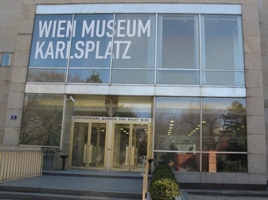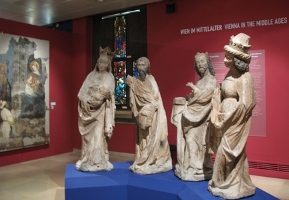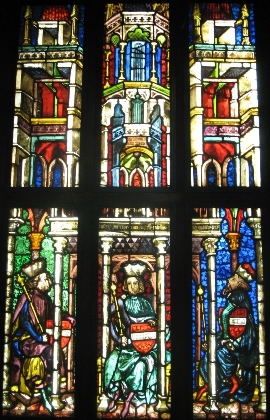
As planned in my last rambling in the center of Vienna, this time would be for Wien Museum Karlsplatz, since I am very intrigued by the idea of exploring Vienna's history. I planned to go there on Moday because there were 2 Biathlon races on Eurosport on Sunday, this time were the Mass Start for Men and the Relay for Women. But after searching information in the Internet, I found a very good deal from this museum on Sunday: simply the permanent exibition is free on Sunday. So why not? Let's see how the trip was.
As usual, I started with tram J to Oper, then walked through the metro station to the opposite side, and turnt left to the museum. It took just 10 to 15 minutes to walk from the tram station to the museum. The weather was nice, sunny, and not very cold, just 7 degree Celcius.
In this period of time, there is a special exhibition about Nagoya - Japan, but in my opinion, it's for European people who like to explore Asian culture. For me, the history of Vienna is my destination this time. The receptionist was very friendly. I just told her that I would like to visit the permanent exhibition, and she immediately gave me a free ticket, show me where to put my bag and didn't forget to ask me not to use flash when taking photos.
Vienna's history is presented from Acient times, Roman times through Middle Ages, some important wars and also important milestones of arts for which this city is famous. Hereafter is information I collected from the museum:
ROMAN VIENNA - VINDOBONA
On the Northern Border of the Roman Empire
In Roman times, Vindobona (later Vienna) served as the garrison of a legion, a port on the Danube and a settlement area for native Celts, who were joined by a diverse population of immigrants from all over the Roman Empire. At this center – situated in what is now Vienna’s 1st district – srood a military encampment, which covered 20 hectares and housed 6,000 soldiers. Approximately 30,000 people lived in the town, making it one of the largest settlements on the northern outskirts of the Empire.
The military base was built at the end of the 1st century A.D. In its vicinity, there emerged a trading center with a highly developed infrastructure, as well as farming and forestry operations.Residential areas were established around the fortifications and in the area making up today’s 3rd district.
All the turn of the 3rd and 4th century A.D., administrative and military reforms, along with several wars and flood that destroyed large part of the town center, led to a reduction in the size of the settlement. The population had to withdraw into a smaller fortress with a reduced garrison. For many centuries thereafter, the area would remain without significance.
VIENNA IN THE MIDDLE AGES

From Babenberg Residence to a City of Free Citizens
Medieval Vienna lived from trade and wine making. Around 800, it was still a small Carolingian border town. It would gain importance in the 12th century, however, when the Babenbergs took up residence there (1143) and construction was begun on St. Stephen’s Cathedral (1137).
The city walls were erected around 1200. At this time, Vienna enjoyed a large degree of autonomy, reflected in the self-gov.ernment of its citizens, as well as their special municipal and trading rights, which allowed for a trading monopoly in Hungary. The city maintained this independence enven during the period of Bohemian rule 1251 to 1276, and 1278 onwards, under the Habsburgs. Next to Cologne, Vienna was considered the most important city in the Holy Roman Empire of German Nations.
In the Late Middle Ages, the Habsburg Court became a cultural hub of Central Europe, attracting numerous musicians and minstrels. The founding of the university in 1365 and Vienna’s elevation to a diocese in 1469 further increased the city’s importance. Outside the city walls, as well, the suburbs were constantly expanding.
In the 15th century, political and economic crises – the massacre and expulsion of Jews in 1421, the Hussite Wars, the shift of the economic centers of Venice and Byzantium to Germany and Flanders – led to a period of stagnation. At the end of the Middle Ages, Vienna fell for a short time under Hungarian rule.
ST. STEPHEN’S CATHEDRAL

The Never Ending Project
The Cathedral of St. Stephen, the symbol of Vienna, is one of the most important buildings of the high and late Gothic period in Central Europe. Towering some 450 feet high, the southern spire is still today the second highest church steeple in the world.
The Diocese of Passau oversaw the intial construction of the cathedral, which was consecrated in 1147. Conceived in Romanesque style and built over a small cemetery chapel, St. Stephen’s underscored the importance of Vienna as a center of trade and residence of the Babenberg rulers. For centuries, the cathedral remained one of the most prestigious projects of the rulers of Austria and the citizens of Vienna. The Habsburgs, and particularly Duke Rudolf the Founder, sought to elevate their place of residence to a separate diocese. It would take until 1469, however, to achieve independence from Passau, the first Viennese bishop being appointed ten years later.
After some initial modifications to the cathedral in the 12th century a project to rebuild St. Stephen’s in Gothic style was undertaken in the High Middle Ages. The reconstruction lasted nearly two hundred years until; in the year 1511 work on the northern spire was stopped. In the 18th century the interior of the cathedral was refurbished in baroque style, and the gables on the southern side were added in the 19th century. Badly damaged during the Second World War St. Stephen’s was rebuilt from 1945 to 1957 with the help of donations from the Austrian population.
The Art Treasures of St. Stephen’s


Windows of St. Stephen Cathedral. Click here for more
Many of the approximately 250 medieval sculptures from St. Stephen’s are made of soft sandstone. These suffered not only from weathering, but also, and from early on, under the effects of industrial air pollution.
After 1863, Friedrich Schmidt undertook major restoration to St. Stephen’s and extended the cathedral by adding the southern gables. In the process, many of the cathedral’s artistic trasures and sculptures were removed and replaced with copies. Numerous Gothic statues and sculptures that had adorned the exterior came into the care of the City of Vienna. Today, they are located at the Wien Museum (Historical Museum of the City of Vienna), along with several Gothic windows from St. Stephen’s, including the “Prince’s Windows” (Furstenfenster). The windows displayed here are among the few surviving originals, since nearly all of those remaining in the cathedral were destroyed by fire in 1945.
Both the sculptures and the glass windows from St. Stephen’s display a strong influence from the workshop of the St. Vitus’s cathedral in Prague. But the artists who made them were also inspired by trends in Southern Germany and Italy.
